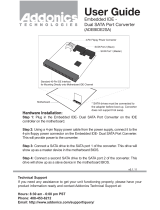
- 4 -
Table of Contents
GA-8N-SLI QUAD Royal Motherboard Layout ............................................................... 6
Block Diagram ................................................................................................................ 7
Chapter 1 Hardware Installation ..................................................................................... 9
1-1 Considerations Prior to Installation .................................................................... 9
1-2 Feature Summary .......................................................................................... 10
1-3 Installation of the CPU and Heatsink .............................................................. 12
1-3-1 Installation of the CPU ......................................................................................... 12
1-3-2 Installation of the Heatsink .................................................................................. 13
1-4 Installing/Removing Cool-Plus (Northbridge Cooling Fan) .............................. 14
1-5 Installation of Memory .................................................................................... 14
1-6 Installation of Expansion Cards ...................................................................... 16
1-7 Setup of SLI (Scalable Link Interface) Configuration ....................................... 17
1-7-1 Before You Begin ................................................................................................. 17
1-7-2 Combination of SLI Applications ........................................................................ 20
1-7-3 Graphic Cards Support List ................................................................................ 20
1-8 Configuring a Multi View System ................................................................... 22
1-8-1 Combination of Multi View Applications .......................................................... 23
1-8-2 Graphic Cards Support List ................................................................................ 23
1-9 I/O Back Panel Introduction ........................................................................... 24
1-10Connectors Introduction ...................................................................................... 25
Chapter 2 BIOS Setup ................................................................................................ 37
The Main Menu (For example: BIOS Ver. : F1) ....................................................... 38
2-1 Standard CMOS Features ............................................................................. 40
2-2 Advanced BIOS Features .............................................................................. 43
2-3 Integrated Peripherals ..................................................................................... 45
2-4 Power Management Setup ............................................................................. 49
2-5 PnP/PCI Configurations ................................................................................. 51
2-6 PC Health Status ........................................................................................... 52
2-7 MB Intelligent Tweaker(M.I.T.) ....................................................................... 53
2-8 Select Language ............................................................................................. 58
2-9 Load Fail-Safe Defaults ................................................................................... 58
2-10 Load Optimized Defaults ................................................................................. 58
2-11 Set Supervisor/User Password ..................................................................... 59
2-12 Save & Exit Setup ......................................................................................... 60
2-13 Exit Without Saving ....................................................................................... 60





















